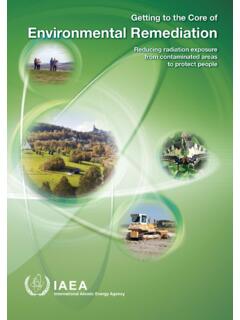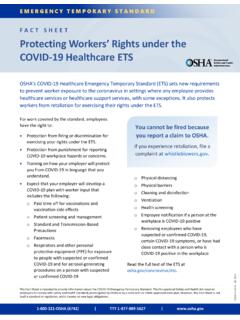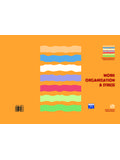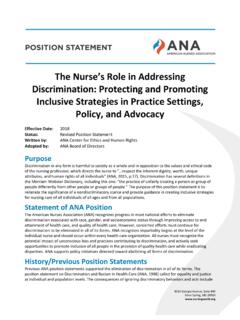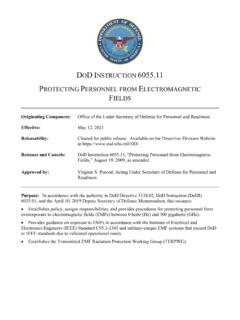Transcription of Using cut-off saws - HSE
1 Page 1 of 4 Health and Safety ExecutiveUsing cut-off sawsA guide to protecting your lungsThis is a web-friendly version of leaflet INDG461, published 03/13 IntroductionIf you are working in highway paving construction or maintenance work, it is highly likely that you use a cut-off saw (also known as a disc cutter, a con saw or a whizzer ). Cutting kerbs, paving or blocks can produce enormous amounts of dust. The dust will contain some very fine dust called respirable crystalline silica (RCS). Exposure to RCS dust can cause serious health problems and may eventually kill and the Highways Agency have produced this leaflet which explains how RCS dust exposure can affect your health and what you can do to control the effectsStones, rocks, sands and clays may contain large amounts of crystalline silica.
2 They are used to make kerbs, flags, bricks, tiles and concrete. Even plastic kerbs can contain a silica-based filler. Cutting these materials produces very fine RCS particles in the airborne dust. These particles are small and you can t always see dust given out by breathing in RCS, you could develop the following lung makes breathing more difficult and increases the risk of lung infections. Silicosis usually follows exposure to RCS over many years, but extremely high exposures can lead rapidly to ill obstructive pulmonary disease (COPD)COPD is a group of lung diseases, including bronchitis and emphysema, resulting in severe breathlessness, prolonged coughing and chronic disability.
3 It may be caused by breathing in any fine dusts, including RCS. It can be very disabling and is a leading cause of death. Cigarette smoking can make it exposure without dust suppression can be massiveHealth and Safety ExecutiveUsing cut-off saws: A guide to protecting your lungs Page 2 of 4 Lung cancerHeavy and prolonged exposure to RCS can cause lung cancer. When someone already has silicosis, there is an increased risk of lung cancer. The health risks from RCS are insignificant when exposure to dust is adequately controlled you do not need to become ill through work aware!
4 You can t always see dust from cutting. Dust could harm workmates and other people standing near you. Managing or reducing the riskDamp down the dustWater suppression is your first line of defence. All modern cut-off saws have an attachment for a water hose. The water can be supplied from a mains feed (the best option) or a pressurised water bottle. We recommend a minimum flow rate of litres per minute to damp down dust a suitable dust maskEven with water suppression, you will need to wear a suitable dust mask (respirator). Nuisance-grade dust masks do not protect your lungs.
5 Use one with an assigned protection factor of 20, even when your water suppression equipment is working effectively. Use either FFP3 filtering facepieces or orinasal respirators with P3 equipmentCheck your machinery and safety equipment regularly. Make sure the water jets are working properly. Maintaining an adequate water flow by cleaning the water jets is essential and should be done at least every time the blades are worn cutting discs to reduce the cutting hoses and bottles. Inspect and maintain re-usable risksMake sure you deal with other risks, eg:noise; flying debris; water spray; You are at risk if the dust you breathe in over a full shift contains more RCS than the amount shown here next to the dustHealth and Safety ExecutiveUsing cut-off saws: A guide to protecting your lungs Page 3 of 4hand-arm vibration; manual handling.
6 Consider the safety of yourself and others when you operate a cut-off saw. Use suitable personal protective equipment, such as hard hats, safety glasses and ear defenders. Make sure these items are worn correctly and are suitable for use !Always damp down dust. Wear a suitable dust mask. Find out moreTo protect employees and others, employers should comply with the workplace health and safety requirements in the Control of Substances Hazardous to Health Regulations 2002 (as amended) (COSHH). HSE has produced simple guidance on how to control RCS exposure in construction.
7 These COSHH essentials guidance sheets are at COSHH essentials sheet CN6 gives guidance on cutting paving and kerbstones with rotary of exposure to silica dust: A guide for employees Leaflet INDG463 HSE Books 2013 have produced a DVD Time to clear the air! Protect your lungs when Using cut-off saws, available from HSE s website at protective equipment at work: A practical guide HSG53 (Third edition) HSE Books 2005 ISBN 978 0 7176 2904 6 can find more information about RPE at HSE s construction web pages at and Safety ExecutivePage 4 of 4 Health and Safety ExecutiveFurther informationFor information about health and safety, or to report inconsistencies or inaccuracies in this guidance, visit You can view HSE guidance online and order priced publications from the website.
8 HSE priced publications are also available from guidance is issued by the Health and Safety Executive. Following the guidance is not compulsory, unless specifically stated, and you are free to take other action. But if you do follow the guidance you will normally be doing enough to comply with the law. Health and safety inspectors seek to secure compliance with the law and may refer to this leaflet is available at Crown copyright If you wish to reuse this information visit for details. First published 03 leaflet is produced in conjunction with the Highways AgencyPublished by the Health and Safety Executive 03/13 INDG461













